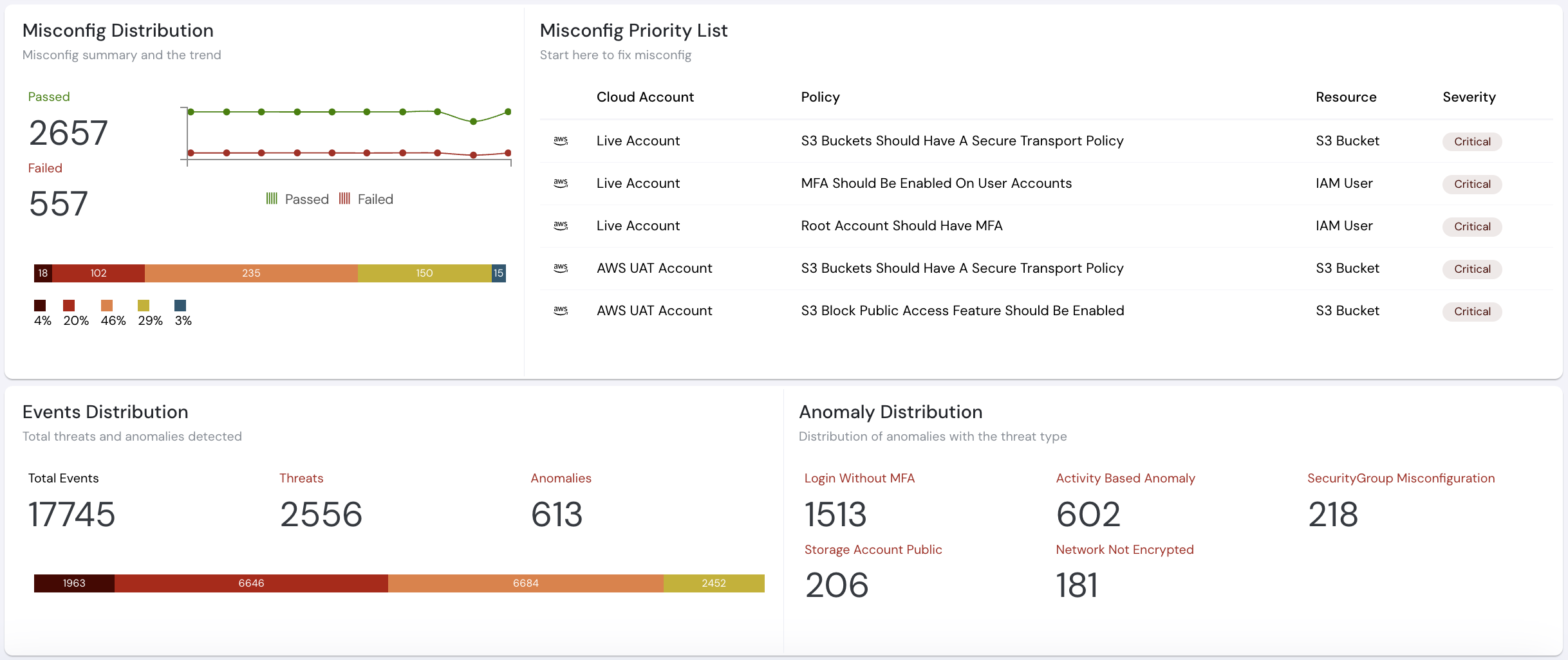
Cloud Native Application Protection Platform (CNAPP) - Complete Guide
What is Cloud Native Application Protection Platform (CNAPP)?
CNAPP is an abbreviation for Cloud Native Application Protection Platform. It is a designed security solution specifically to protect cloud-native applications throughout their lifecycle. A CNAPP solution offers security solutions across all stages of the application lifecycle and includes:
- Code security
- DevSecOps integration
- Workload protection
- Cloud Security Posture Management (CSPM)
- Identity and Access Management
- Data security
Why Was CNAPP Born?
Organizations started to consume numerous point security solutions and realized they now have anywhere between 10-17 point solutions to get basic security around code and cloud. While these tools provided individual dashboards, consumers were still left with the question: “What should be my priority?”
The reason was that these individual dashboards were like islands of information that didn’t communicate or correlate security information with each other.
CNAPP, on the other hand, includes all the necessary survival tools required to protect your applications throughout their lifecycle (SDLC), from initial development to runtime.
Key Aspects of CNAPP
CNAPP is typically broken down into two key aspects:
1. Unified Platform
Instead of juggling multiple security tools for different aspects of your cloud applications, CNAPP brings everything together. It acts as a central hub, simplifying security management and streamlining workflows for your security team.
2. Cloud Native Focus
Since cloud-native applications are built and operated differently, CNAPP offers features that cater to their specific needs, like container security and protection for microservices architectures.
Why is CNAPP Important for Businesses?
Traditional applications were often built and deployed in a monolithic way, meaning everything was bundled together. Cloud-native applications, on the other hand, are built with modular components and leverage cloud technologies. This brings its own set of challenges.
7 Key Problems CNAPP Addresses
1. Disparate Security Tools
Cloud-native applications often require a variety of security tools for tasks like code scanning, workload protection, and cloud configuration management. CNAPP consolidates these functionalities into a single platform, eliminating the need to manage and integrate multiple security solutions.
2. DevSecOps Integration Challenges
Integrating security into development processes is crucial for identifying and fixing vulnerabilities proactively. CNAPP offers features that integrate seamlessly with development tools and workflows, allowing developers to identify and address security issues during the coding stage.
3. Container Security Risks
Containerization is popular for building and deploying cloud-native applications but introduces new security risks. CNAPP offers features like:
- Container image scanning
- Runtime protection for containerized workloads
4. Cloud Misconfiguration
Cloud environments are complex, and misconfigurations often create security vulnerabilities. CNAPP incorporates Cloud Security Posture Management (CSPM) capabilities to continuously monitor your cloud environment for misconfigurations and potential security weaknesses.
5. Runtime Threats
Even after deployment, cloud-native applications are susceptible to runtime threats like:
- Malware
- Zero-day exploits
- Unauthorized access attempts
CNAPP provides workload protection features to monitor running applications and identify and respond to these threats in real time.
6. Data Security Concerns
Cloud-native applications often process sensitive data. CNAPP offers data security features to help organizations ensure the confidentiality and integrity of their sensitive data throughout its lifecycle and help them with Data Access Management (DAM).
7. IAM Just-in-Time (JIT) Privilege Elevation
Cloud-native environments require frequent and dynamic access to resources. CNAPP integrates Just-in-Time (JIT) privilege elevation, granting users or applications temporary, scoped access only when needed. This approach significantly reduces the attack surface by minimizing standing privileges.
Benefits of CNAPP
Organizations that rely heavily on cloud-native applications and prioritize robust security are prime candidates for CNAPP. This includes companies in sectors like:
- E-commerce
- Financial Services (FSI)
- Insurance
- Fintech
- Software as a Service (SaaS)
8 Key Benefits
- Improved Security Posture: Provides a comprehensive approach to secure cloud-native applications across the entire lifecycle
- Streamlined Security Operations: Simplifies security operations by offering a unified platform for various security tasks
- Enhanced Developer Productivity: Integrates with developer tools and workflows for proactive security
- Improved Visibility and Control: Provides centralized security view of cloud-native applications
- Faster Threat Detection and Response: Offers real-time threat detection and quick response capabilities
- Simplified Compliance Management: Helps meet compliance requirements through centralized security management
- Scalability and Agility: Built to keep pace with the agile nature of cloud-native applications
- Cost Optimization: Potentially reduces security costs by eliminating multiple security solutions
Challenges of CNAPP
While CNAPP offers numerous benefits, organizations face several challenges when adopting and implementing these solutions:
Implementation Challenges
- Integration Complexity: Integrating with existing security tools and workflows can be complex
- Evolving Technology Landscape: Must keep pace with rapidly changing cloud threats and vulnerabilities
- Solution Maturity: Some CNAPP solutions might be in early development stages
- Vendor Lock-in: Relying solely on a single CNAPP provider can limit flexibility
- Continuous Monitoring Requirements: Still requires ongoing security monitoring and management
- Data Privacy Considerations: Must ensure proper data privacy controls for sensitive information
- Skill Shortage: Requires skilled security professionals who understand both cloud-native technologies and CNAPP functionalities
Gartner Recommendations for CNAPP
Focus on Lifecycle Protection
Gartner emphasizes the importance of CNAPP solutions that provide security across the entire application lifecycle:
- DevSecOps Integration: Integrate security tools into development processes
- Workload Protection: Safeguard runtime applications from threats
- Cloud Security Posture Management (CSPM): Monitor cloud environments for misconfigurations
- Data Security: Ensure confidentiality and integrity of sensitive data
Embrace Flexibility
Gartner recommends CNAPP solutions that offer various runtime visibility techniques:
- Traditional Agents: Provide in-depth visibility into application behavior
- Extended Berkeley Packet Filter (eBPF): Enable efficient monitoring of containerized applications
- Snapshotting: Allow periodic captures of application state for security analysis
- Privileged Containers and Kubernetes Integration: Enable seamless security controls with container orchestration
Protect Your Application
Select CNAPP solutions that understand the ownership and provenance of development artifacts. An ideal CNAPP solution should track:
- Which developer/development team created the artifact
- When it was scanned
- When it was deployed
- Who has modified it since
CNAPP vs CWPP: Key Differences
| Aspect | CNAPP | CWPP |
|---|---|---|
| Scope | Entire lifecycle of cloud-native applications | Focused on workload protection only |
| Coverage | Development to runtime | Primarily runtime |
| Features | DevSecOps, workload protection, CSPM, data security | Workload security within cloud environments |
| Focus | Comprehensive application protection | Specialized workload protection |
Think of CNAPP as a broader security toolkit for cloud-native applications, whereas CWPP is a specialized tool focused on workload protection only.
Problems CNAPP Solves
CNAPP specifically addresses several cloud-related security problems:
Cloud-Specific Challenges
- Increased Attack Surface: Provides consolidated view across complex cloud environments
- Shared Responsibility Model: Bridges the gap between cloud provider and user responsibilities
- Dynamic Cloud Environment: Adapts to constantly changing cloud infrastructure
- Lack of Cloud-Native Expertise: Offers user-friendly solutions with automation
- Fragmented Security Tools: Consolidates multiple security functionalities into unified platform
- Cloud Workload Vulnerabilities: Integrates with containerization technologies like Docker and Kubernetes
- Misconfigurations: Identifies and remediates cloud infrastructure misconfigurations
- Insider Threats: Includes features like User Behavior Analytics (UBA) for suspicious activity detection
Best Practices for CNAPP Implementation
Key Recommendations
- Thoroughly assess your requirements and challenges before CNAPP adoption
- Develop strategies to mitigate potential implementation risks
- Evaluate different CNAPP solutions based on specific security needs
- Consider vendor lock-in risks during solution selection
- Ensure adequate skilled personnel for effective utilization
- Maintain continuous security monitoring and management practices
Conclusion
“Security is not a set-and-forget practice!”
Continuous efforts to improve your security posture by evaluating security methods and proactively addressing issues in your cloud infrastructure will keep you ahead of threats.
In a world where threats can emerge from anywhere, comprehensive CNAPP solutions provide ultimate defense by seamlessly integrating security across Code, Cloud, Identity, and Workloads to anticipate and block multi-surface attacks.
This guide provides a comprehensive overview of Cloud Native Application Protection Platform (CNAPP) and its role in modern cloud security.
